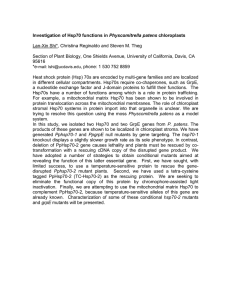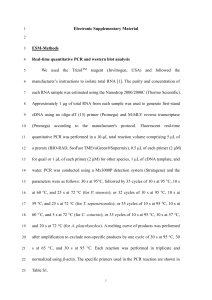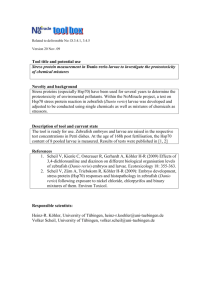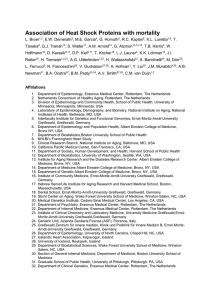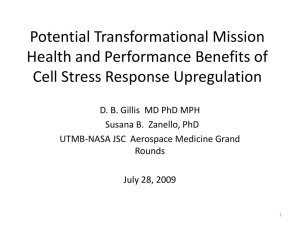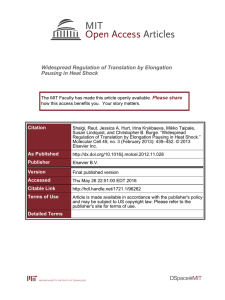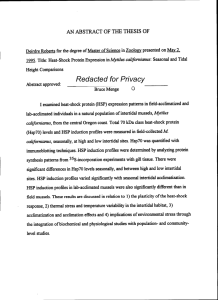P1.59 P3.195 Stress distribution and morphological specializations in the feeding
advertisement
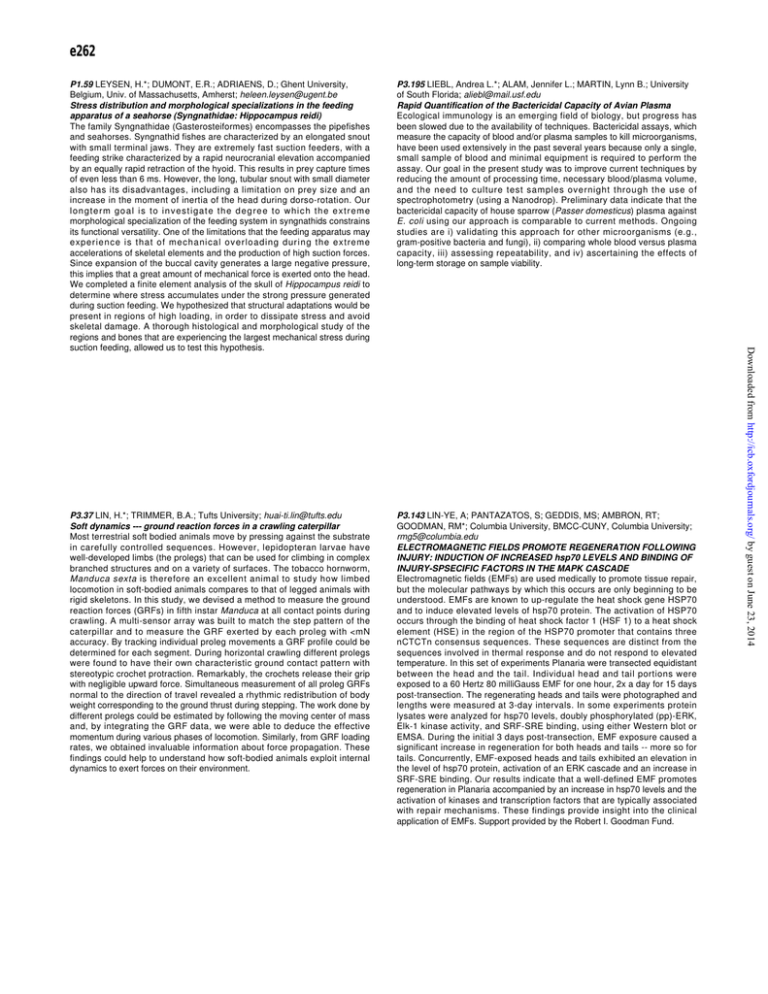
e262 P3.195 LIEBL, Andrea L.*; ALAM, Jennifer L.; MARTIN, Lynn B.; University of South Florida; aliebl@mail.usf.edu Rapid Quantification of the Bactericidal Capacity of Avian Plasma Ecological immunology is an emerging field of biology, but progress has been slowed due to the availability of techniques. Bactericidal assays, which measure the capacity of blood and/or plasma samples to kill microorganisms, have been used extensively in the past several years because only a single, small sample of blood and minimal equipment is required to perform the assay. Our goal in the present study was to improve current techniques by reducing the amount of processing time, necessary blood/plasma volume, and the need to culture test samples overnight through the use of spectrophotometry (using a Nanodrop). Preliminary data indicate that the bactericidal capacity of house sparrow (Passer domesticus) plasma against E. coli using our approach is comparable to current methods. Ongoing studies are i) validating this approach for other microorganisms (e.g., gram-positive bacteria and fungi), ii) comparing whole blood versus plasma capacity, iii) assessing repeatability, and iv) ascertaining the effects of long-term storage on sample viability. P3.37 LIN, H.*; TRIMMER, B.A.; Tufts University; huai-ti.lin@tufts.edu Soft dynamics --- ground reaction forces in a crawling caterpillar Most terrestrial soft bodied animals move by pressing against the substrate in carefully controlled sequences. However, lepidopteran larvae have well-developed limbs (the prolegs) that can be used for climbing in complex branched structures and on a variety of surfaces. The tobacco hornworm, Manduca sexta is therefore an excellent animal to study how limbed locomotion in soft-bodied animals compares to that of legged animals with rigid skeletons. In this study, we devised a method to measure the ground reaction forces (GRFs) in fifth instar Manduca at all contact points during crawling. A multi-sensor array was built to match the step pattern of the caterpillar and to measure the GRF exerted by each proleg with <mN accuracy. By tracking individual proleg movements a GRF profile could be determined for each segment. During horizontal crawling different prolegs were found to have their own characteristic ground contact pattern with stereotypic crochet protraction. Remarkably, the crochets release their grip with negligible upward force. Simultaneous measurement of all proleg GRFs normal to the direction of travel revealed a rhythmic redistribution of body weight corresponding to the ground thrust during stepping. The work done by different prolegs could be estimated by following the moving center of mass and, by integrating the GRF data, we were able to deduce the effective momentum during various phases of locomotion. Similarly, from GRF loading rates, we obtained invaluable information about force propagation. These findings could help to understand how soft-bodied animals exploit internal dynamics to exert forces on their environment. P3.143 LIN-YE, A; PANTAZATOS, S; GEDDIS, MS; AMBRON, RT; GOODMAN, RM*; Columbia University, BMCC-CUNY, Columbia University; rmg5@columbia.edu ELECTROMAGNETIC FIELDS PROMOTE REGENERATION FOLLOWING INJURY: INDUCTION OF INCREASED hsp70 LEVELS AND BINDING OF INJURY-SPSECIFIC FACTORS IN THE MAPK CASCADE Electromagnetic fields (EMFs) are used medically to promote tissue repair, but the molecular pathways by which this occurs are only beginning to be understood. EMFs are known to up-regulate the heat shock gene HSP70 and to induce elevated levels of hsp70 protein. The activation of HSP70 occurs through the binding of heat shock factor 1 (HSF 1) to a heat shock element (HSE) in the region of the HSP70 promoter that contains three nCTCTn consensus sequences. These sequences are distinct from the sequences involved in thermal response and do not respond to elevated temperature. In this set of experiments Planaria were transected equidistant between the head and the tail. Individual head and tail portions were exposed to a 60 Hertz 80 milliGauss EMF for one hour, 2x a day for 15 days post-transection. The regenerating heads and tails were photographed and lengths were measured at 3-day intervals. In some experiments protein lysates were analyzed for hsp70 levels, doubly phosphorylated (pp)-ERK, Elk-1 kinase activity, and SRF-SRE binding, using either Western blot or EMSA. During the initial 3 days post-transection, EMF exposure caused a significant increase in regeneration for both heads and tails -- more so for tails. Concurrently, EMF-exposed heads and tails exhibited an elevation in the level of hsp70 protein, activation of an ERK cascade and an increase in SRF-SRE binding. Our results indicate that a well-defined EMF promotes regeneration in Planaria accompanied by an increase in hsp70 levels and the activation of kinases and transcription factors that are typically associated with repair mechanisms. These findings provide insight into the clinical application of EMFs. Support provided by the Robert I. Goodman Fund. Downloaded from http://icb.oxfordjournals.org/ by guest on June 23, 2014 P1.59 LEYSEN, H.*; DUMONT, E.R.; ADRIAENS, D.; Ghent University, Belgium, Univ. of Massachusetts, Amherst; heleen.leysen@ugent.be Stress distribution and morphological specializations in the feeding apparatus of a seahorse (Syngnathidae: Hippocampus reidi) The family Syngnathidae (Gasterosteiformes) encompasses the pipefishes and seahorses. Syngnathid fishes are characterized by an elongated snout with small terminal jaws. They are extremely fast suction feeders, with a feeding strike characterized by a rapid neurocranial elevation accompanied by an equally rapid retraction of the hyoid. This results in prey capture times of even less than 6 ms. However, the long, tubular snout with small diameter also has its disadvantages, including a limitation on prey size and an increase in the moment of inertia of the head during dorso-rotation. Our longterm goal is to investigate the degree to which the extreme morphological specialization of the feeding system in syngnathids constrains its functional versatility. One of the limitations that the feeding apparatus may experience is that of mechanical overloading during the extreme accelerations of skeletal elements and the production of high suction forces. Since expansion of the buccal cavity generates a large negative pressure, this implies that a great amount of mechanical force is exerted onto the head. We completed a finite element analysis of the skull of Hippocampus reidi to determine where stress accumulates under the strong pressure generated during suction feeding. We hypothesized that structural adaptations would be present in regions of high loading, in order to dissipate stress and avoid skeletal damage. A thorough histological and morphological study of the regions and bones that are experiencing the largest mechanical stress during suction feeding, allowed us to test this hypothesis.
